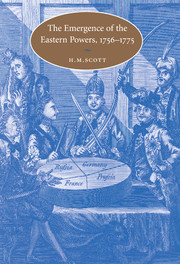Book contents
- Frontmatter
- Contents
- List of maps and genealogical table
- Acknowledgements
- A note on dates and place names
- List of abbreviations
- Introduction: the eighteenth-century European states system and its transformations
- 1 The rise of the eastern powers
- 2 The Seven Years War and the European states system
- 3 The domestic legacies of the Seven Years War
- 4 The stabilisation of Europe, 1763–1766
- 5 Diplomacy and the eastern powers
- 6 From peace to war, 1766–1768
- 7 The partition of Europe, 1768–1772
- 8 The advance of Russia, 1772–1775
- Conclusion: Russia and the emergence of the eastern powers
- Bibliography
- Index
- CAMBRIDGE STUDIES IN EARLY MODERN HISTORY
Introduction: the eighteenth-century European states system and its transformations
Published online by Cambridge University Press: 16 July 2009
- Frontmatter
- Contents
- List of maps and genealogical table
- Acknowledgements
- A note on dates and place names
- List of abbreviations
- Introduction: the eighteenth-century European states system and its transformations
- 1 The rise of the eastern powers
- 2 The Seven Years War and the European states system
- 3 The domestic legacies of the Seven Years War
- 4 The stabilisation of Europe, 1763–1766
- 5 Diplomacy and the eastern powers
- 6 From peace to war, 1766–1768
- 7 The partition of Europe, 1768–1772
- 8 The advance of Russia, 1772–1775
- Conclusion: Russia and the emergence of the eastern powers
- Bibliography
- Index
- CAMBRIDGE STUDIES IN EARLY MODERN HISTORY
Summary
On 17 March 1778 the House of Commons began to consider the treaties between France and Britain's rebellious North American colonists. These had been signed early in February, and their formal communication to London signalled open French intervention in the War of American Independence. In the course of this debate Charles Jenkinson offered an incisive if pessimistic analysis of the predicament facing Britain. Her diplomatic isolation and accompanying political decline, he declared, were due to a wider and quite fundamental transformation:
The great military powers in the interior parts of Europe, who have amassed together their great treasures, and have modelled their subjects into great armies, will in the next and succeeding period of time, become the predominant powers. France and Great Britain, which have been the first and second-rate powers of the European world, will perhaps for the future be but of the third and fourth rate.
Though acute, Jenkinson's analysis was too sanguine. During the 1770s Russia, Prussia and Austria, ‘the great military powers in the interior parts of Europe’, were already becoming the leading continental states: what he termed the ‘predominant powers’. Their political rise during the third quarter of the eighteenth century is the subject of this book.
The emergence of the eastern powers was a turning point in the evolution of the modern European states system. During the century after the Peace of Westphalia (1648) international relations had been shaped primarily by attempts to contain the French monarchy, the one true great power of that era.
- Type
- Chapter
- Information
- The Emergence of the Eastern Powers, 1756–1775 , pp. 1 - 10Publisher: Cambridge University PressPrint publication year: 2001

